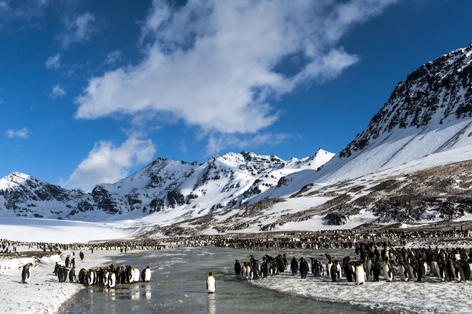Adolescent men frequently fight to resolve disagreements, but the bloodiest of battles nearly always involve a female. In the case of this particular fracas, escalating just metres in front of me, there are several young ladies at stake.
Like gladiators in a Roman arena, our two hormone-fuelled combatants size each other up, their bloodshot eyes raging with anger, as we prepare for the tournament to commence.
In September and October, South Georgia’s beaches are overrun with elephant seals coming ashore to give birth and mate, and alpha male beachmasters, identifiable by their distinctive inflated proboscis, must constantly defend their harems.
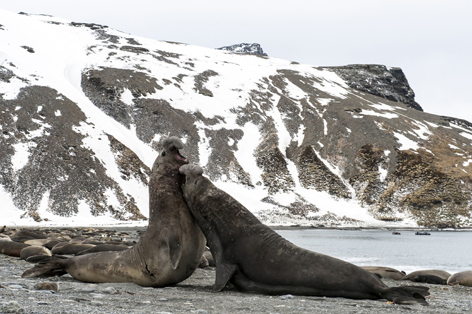 Rearing up in unison, our two suitors swing at each other with audible, thudding force, sending both bodily fluid and fear along the length of the beach.
Rearing up in unison, our two suitors swing at each other with audible, thudding force, sending both bodily fluid and fear along the length of the beach.
It’s a brutal, gruesome battle, and there can only be one victor. Despite his injuries, the beachmaster manages to retain control, and to cement his win, he wriggles over to a submissive female and begins to mate.
There’s no time to waste on courtship and pleasantries; in such a harsh environment, every day is a struggle for survival.
A British Overseas Territory in the Southern Atlantic Ocean, subantarctic island South Georgia is arguably one of the world’s most pristine and abundant wildlife havens. Yet, remoteness (no planes can land here) and fierce weather conditions make it extremely difficult to visit. Most of the 7,000 annual tourists spend two to three days here as part of a longer itinerary to the Antarctic Peninsula.
Hoping to examine the island in greater depth, I’ve joined a new South Georgia focused voyage with Canadian expedition company One Ocean Expeditions – currently the only itinerary of this type available. Travelling in October, earlier than any other ship, no one really knows what to expect.
A willingness to embrace the unknown is something we share with one of South Georgia’s earliest explorers, Sir Ernest Shackleton, who famously traversed the island after two years of being lost on the ice following a failed Antarctic mission.
2016 marks the centenary of his safe arrival at the Stromness Bay whaling station, and we’re joined on board by a team of young explorers sponsored by the Antarctic Heritage Trust, who are planning to replicate his journey on skis. Next year, adventurous passengers on this voyage will be able to do the same.
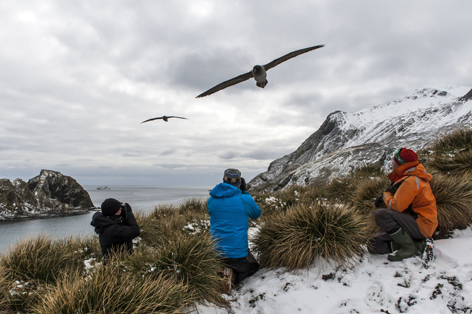 Our 14-day trip begins from Stanley on the Falkland Islands (reached by a scheduled LATAM flight from Santiago, Chile), and we spend the first two days at sea in the company of albatrosses, petrels and prions as we travel 800 nautical miles to South Georgia.
Our 14-day trip begins from Stanley on the Falkland Islands (reached by a scheduled LATAM flight from Santiago, Chile), and we spend the first two days at sea in the company of albatrosses, petrels and prions as we travel 800 nautical miles to South Georgia.
Keen to drop off our expedition ski team before bad weather sets in, we head straight for King Haakon Bay on the west coast, where Shackleton and his two crewmen, Frank Worsley and Tom Crean, landed in the James Caird lifeboat after a turbulent 16-day sailing from Elephant Island.
A furious snow squall cuts short our excursion, and we return to our ship, the 90-passenger Akademik Sergey Vavilov, while the explorers prepare to camp for two nights on the ice.
Fortunately, an extended trip to South Georgia allows us time to ride out storms and land at spots usually skipped by ships on a tight timetable to reach Antarctica.
At Elsehul, a narrow bay on the very western tip of the island, we watch light-mantled sooty and grey-headed albatross swoop overhead, some gliding so low I’m almost knocked over by the powerful wind beneath their wings.
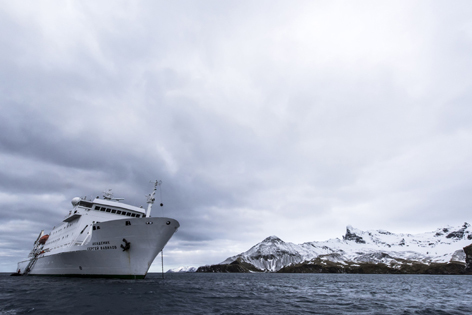 We also have a permit to visit Prion Island, where wandering albatross nest. An abundance of ankle-biting fur seals prevents ships visiting in summer months, but for now, the tussocks are comfortably calm. Several large and ungainly chicks are still in grassy nests, displaying tufty, down-covered faces only a mother could love. As the wind picks up, they awkwardly flap wings in preparation for maiden flights, like clumsy competitors in a Birdman competition.
We also have a permit to visit Prion Island, where wandering albatross nest. An abundance of ankle-biting fur seals prevents ships visiting in summer months, but for now, the tussocks are comfortably calm. Several large and ungainly chicks are still in grassy nests, displaying tufty, down-covered faces only a mother could love. As the wind picks up, they awkwardly flap wings in preparation for maiden flights, like clumsy competitors in a Birdman competition.
Wherever we are, a similar soundtrack plays – the chirping melody of the world’s most southerly songbird, the South Georgia pipit.
Up until recently, this sparrow-like bird was highly endangered, but following the world’s largest rat eradication programme in 2011, the population is bouncing back.
“We are tripping over wildlife in South Georgia, but it’s a fraction of what it should be,” says Sarah Lurcock from the South Georgia Heritage Trust, who oversaw the £7.5million four-year project.
There’s certainly no shortage of birds at Jason Harbour, where opportunistic skuas and southern giant petrels predate on vulnerable newborn elephant seals. On this occasion, they make do with a bloody mass of afterbirth, permitting the balls of matted wet fur to share a few tender moments with their mothers. Within several weeks, the defenceless pups will be abandoned when their parents return to sea.
Luckily the same fate doesn’t beset our tired and windswept explorers, who we pick up at Stromness, a little further along the north coast.
It was a bell from the whaling station 100 years ago in May 1916 which signalled Shackleton’s first encounter with human habitation in two years. He followed the sound to the station manager’s hut, where he famously took a long awaited bath.
A hot shower is on the cards for our own intrepid team, who later enthusiastically share details of their adventure – including the purpose of plastic pots used to ensure they “left no trace”.
Their journey took them across expansive snowscapes and sweeping glaciers, and we’re given a taste of that unadulterated icy wonderland on a trip to St Andrews Bay, further south. The swell makes it notoriously tough to land here, but the promise of the largest king penguin rookery in the world is enough to spur us on.
At 7am, our Zodiac rolls up on a black beach carpeted with elephant seals, whose frozen whiskers make them look like grumpy old men. I hike for 45 minutes beneath the shadow of steep-sided mountains, where sharp, snow-covered peaks are framed by indigo sky. Oily white penguin bellies shimmer in the sunshine, their yellow crowns now glowing regal gold.
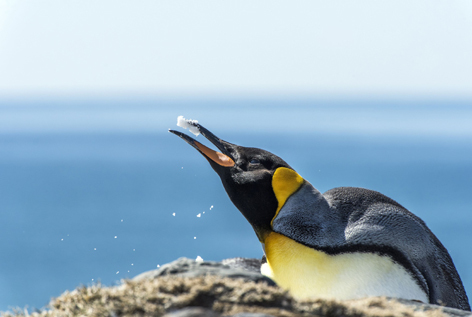 Below a ridge lies the bulk of the 200,000-strong colony, so vast I have to swivel my head 180 degrees to take in the view. Penguins zigzag to the base of the Cook Glacier, where an icy tongue extends into the ocean, and I spend hours tracing geometric patterns of seabirds, frozen rivers and exposed rock in the snow. A fanfare of trumpet calls rings out across the bay as penguins corkscrew their heads skyward in what I imagine to be a celebration of the stark beauty of this place.
Below a ridge lies the bulk of the 200,000-strong colony, so vast I have to swivel my head 180 degrees to take in the view. Penguins zigzag to the base of the Cook Glacier, where an icy tongue extends into the ocean, and I spend hours tracing geometric patterns of seabirds, frozen rivers and exposed rock in the snow. A fanfare of trumpet calls rings out across the bay as penguins corkscrew their heads skyward in what I imagine to be a celebration of the stark beauty of this place.
Historically, not everyone has seen South Georgia in such a favourable light.
Johann Forster, the naturalist who joined Captain Cook on his voyage of discovery here in 1775, declared the “inhospitable, cursed regions” to be a fitting punishment for those guilty of “heinous crimes”.
If that be the case, convict me now and throw away the key.
TRAVEL FACTS
Sarah Marshall was a guest of One Ocean Expeditions (www.oneoceanexpeditions.com) who offer a South Georgia In Depth voyage on October 15-31, 2016 (16-nights) and Jan 28- Feb 11, 2017 (14-nights). Prices start from 12,395 US dollars per person, sharing a twin cabin and including a flight from Punta Arenas to the Falkland Islands, all meals and accommodation on board ship, Zodiac excursions and landings, ship transfers and foul weather gear.
LATAM (www.lan.com) offer flights from London Heathrow to Puenta Arenas, Chile, then returns from Ushuaia, Argentina to London from £1,181pp. They also fly to the Falkland Islands.
